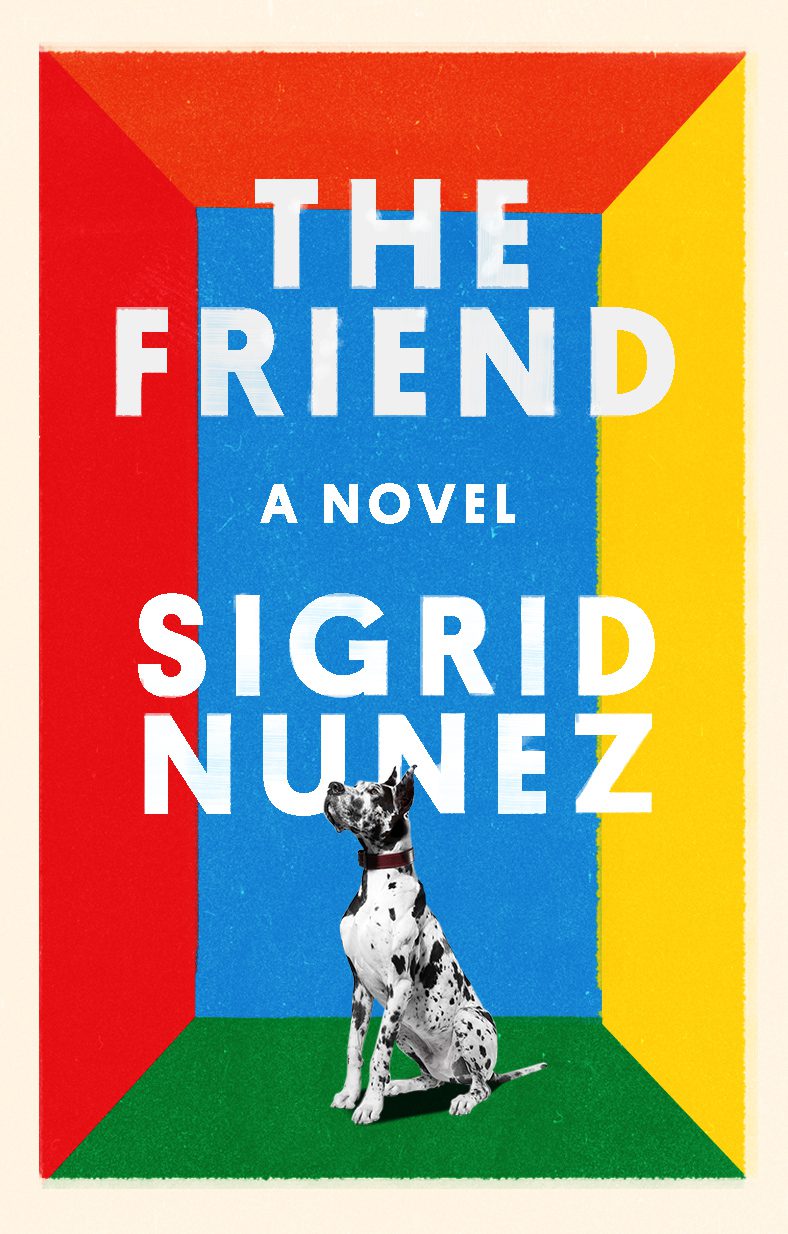In Sigrid Nunez’s seventh novel, The Friend, the unnamed narrator, a writer, loses her friend and mentor to suicide. She then adopts his Great Dane—even though she lives in a 500-square-foot New York apartment where dogs are prohibited.
The Friend is a brilliant examination of the writer’s life, literary friendship, mortality, bereavement, and our relationship to animals. The novel is not easily summarized; the true rewards of this reading experience are the crystalline prose. “Wife Three, it must be said, looked radiant, though it was a cold radiance like that of a blade. Treat me like an object of pity […] and I will cut you,” she writes. The subtle humor also propels the narrative: “Once you cracked us up with the line I think I’d prefer a novella of a life.” At the memorial, someone says, “Now he’s officially a dead white male.” Readers will also savor the surprising shifts in narrative focus.
Not long ago, I spoke to Ms. Nunez about the ways her novel mourns a person, and a vanished literary world, while examining our bond with animals.
***
The Rumpus: You’re a master at writing about animals. Mitz, a fictional biography of Virginia Woolf’s marmoset, is a prime example. You write about animals with real feeling and zero sentimentality, with fantastic details, such as the Great Dane’s paw being like “a castle door knocker.”
The Friend proves that a book about a dog is not the same as a “dog book.” What do you find most enjoyable and challenging about writing about animals?
Sigrid Nunez: I’ve always loved animals—all animals, really—and I find writing about them a lot of fun. What I’m not so interested in is writing from an animal’s point of view, though I sometimes try to. Whenever I read something that’s supposed to be an animal narrating, I find I can’t accept it, because it’s always obviously a human’s point of view.
It’s impossible to present, through language—which animals don’t have, after all—a convincing portrait of what goes on inside an animal’s head. But writing about animal behavior, based on close observation, and trying to imagine what an animal’s inner life might be like—that I do find fascinating.
Rumpus: You write that today’s creative writing students no longer feel that writing is a religion, as Rilke describes it in his Letters to a Young Poet. This book spoke more to your generation than more recent ones, you suggest. Why?
Nunez: I was really thinking about the kind of response I’ve had from students when I’ve taught that book. Very few are moved by it the way I remember my fellow students and I being moved. Many of them find it laughable. I think writers now are more likely to see writing as a possible means of advancing oneself in the world and increasing self-esteem rather than as a vocation, “like being a nun or a priest,” as Edna O’Brien described it.
When I was young, all the writers I looked up to shared this idea of literature as something sacred. But the attitude toward writing is much more casual today, and there are plenty of people who are more likely to think of writing as self-expression and self-help.
Rumpus: There are some funny, unsettling, and terrifying notions about the future of writers in this book. Twelve authors pose naked for a calendar, for example. Before the writer friend commits suicide, he predicts there will be a wave of author suicides. Can you talk about what compelled you to imagine this surreal, dark world?
Nunez: The idea of a nude calendar posed for by twelve hot writers doesn’t seem at all far-fetched to me. About suicide: there has always been a high rate of suicide among writers, and there’s been a huge surge in suicide among the broader population in the US in recent years.
A friend of mine—a writer—committed suicide while I was writing The Friend, and I’ve been told by several other writers I know that the idea of taking their own lives is something they think about all the time.
Dark, yes, but I wouldn’t call it surreal.
Rumpus: The late mentor offers lots of advice and wisdom to his friend and mentee. He says that “there is at least one book in you that cannot be written by anyone else but you,” and that “no writing is ever wasted,” because even abandoned drafts can teach you something.
Do you agree with this advice, and do you generally believe in the usefulness of writing advice?
Nunez: I’d call this sound advice. As for other writing advice, I’ve seen some bad and a lot good. Some of the worst advice I’ve seen is in writing manuals, with their endless mechanical exercises. Some of the best advice is to be found in Flannery O’Connor’s letters and in her book of occasional prose, Mystery and Manners.
Rumpus: You write about shame and self-loathing among writers, and the guilt of writers stealing material from the lives of others. Can you talk about how you’ve managed to deal with this in your own writing life?
Nunez: “There’s nothing more embarrassing than being a poet,” according to Elizabeth Bishop. It’s well known that many writers—including great ones like Bishop—feel shame about what they do, but it’s hard to say exactly why. I had a student who believed that writing was evil by definition because it “broke the silence.” But what does that actually mean? Does that make music evil, too?
I think the only way to deal with the problem of self-loathing is to accept it as part of the process, and to try not to let it overwhelm you by promising yourself to write as well as you possibly can.
It’s an inescapable fact that fiction often depends on using material from other people’s lives, whether it’s people you know or people you’ve never met. But I believe that, as with any other human endeavor, there’s a way to do this with integrity, and if for whatever reason you can’t find such a way, maybe you should write about something else.
Rumpus: Authors like Jenny Offill (Dept. of Speculation) have been celebrated for interspersing erudite tidbits into their narratives. You include paragraph-long reflections on the chemical composition of tears, and quotes and reflections on everything from Rilke to Rapunzel. Since 1995’s A Feather on the Breath of God, you have always blended elements of nonfiction and fiction. There seems a newfound appreciation for these kinds of innovations. So why do writing teachers continue to push new writers to put everything “in scene,” avoid leaving a character alone with her thoughts, and remove exposition? Is exposition only for advanced writers?
Nunez: This is probably a result of teachers’ frustration with inexperienced writers’ well-known tendency to write stories that are too diffuse or abstract. I don’t think anyone would suggest that Joyce should not have left Molly Bloom alone with her thoughts. As a writer you find the form that best allows you to tell the story you want to tell. In many cases, this can’t be done all “in scene.” Characters in good fiction think, reflect, and meditate upon things all the time. The house of fiction has many rooms. There are many kinds of novels, including one kind that I happen to be very drawn to, in which elements of fiction and nonfiction are mixed. This hybrid form may appeal to more and more writers today, but it’s also been around a very long time. Think of Proust.
Rumpus: You write about the notion of “strays,” people who haven’t married or had children and prefer being alone during holidays even if they have invitations from friends. Do you think that strays are given adequate attention in fiction, or is there a bias towards books about the family?
Nunez: I got the idea about strays from Renata Adler. It was her word for the kind of person who never really becomes a part of life in the way most people do. The person may have serious romantic relationships and friendships and may even spend a lot of time with other people, but they remain single and childless and essentially solitary.
I wouldn’t be surprised if we started seeing an increase in fiction about this kind of character, and I would guess that, in almost every case, the character will be female.





